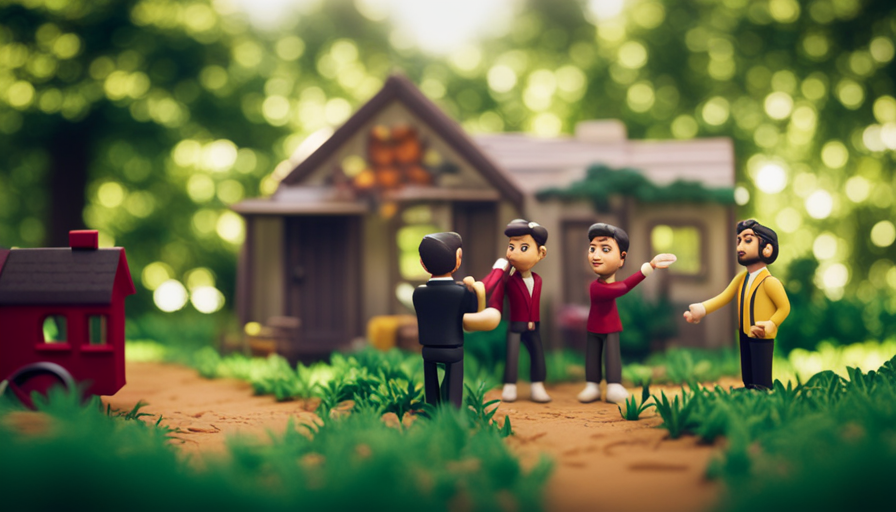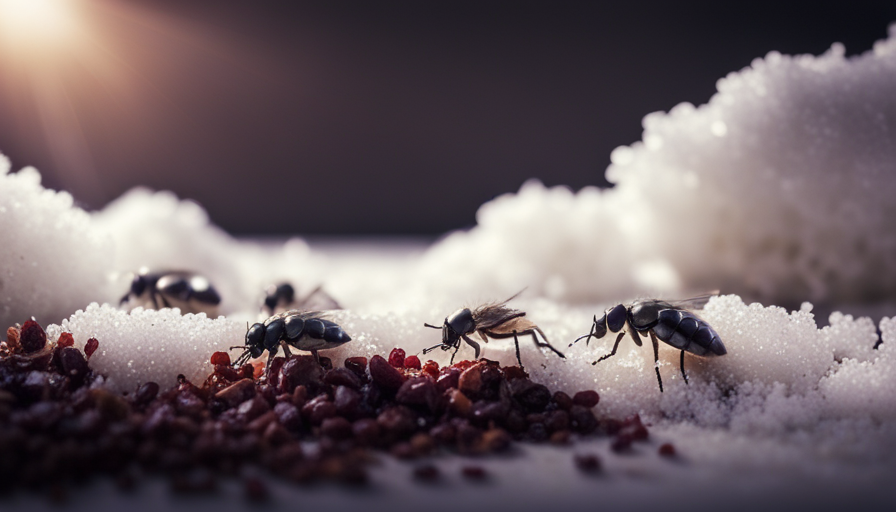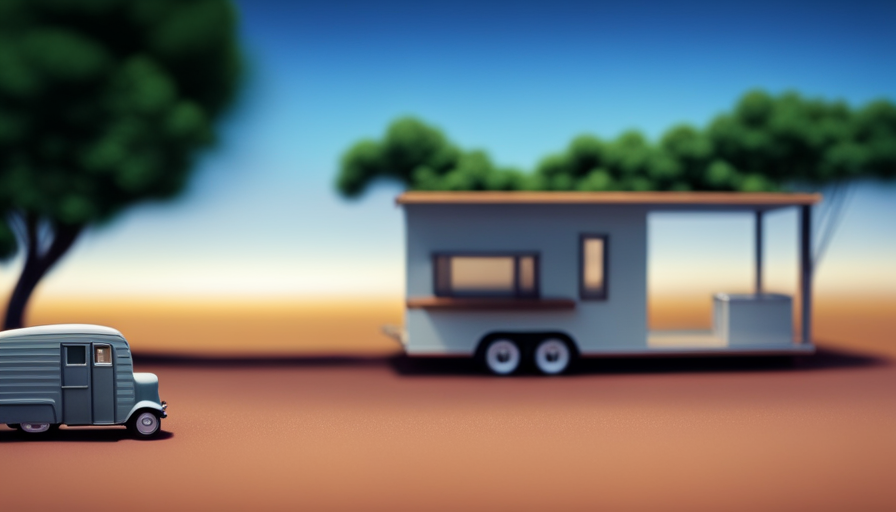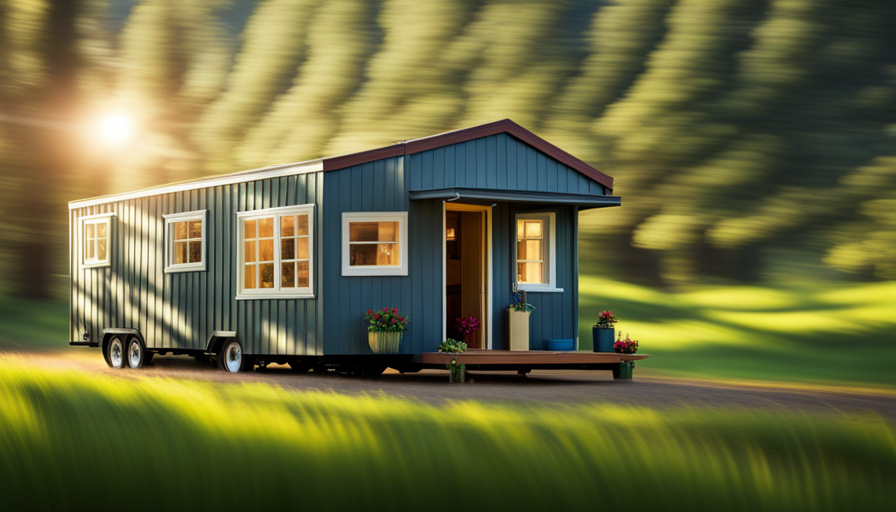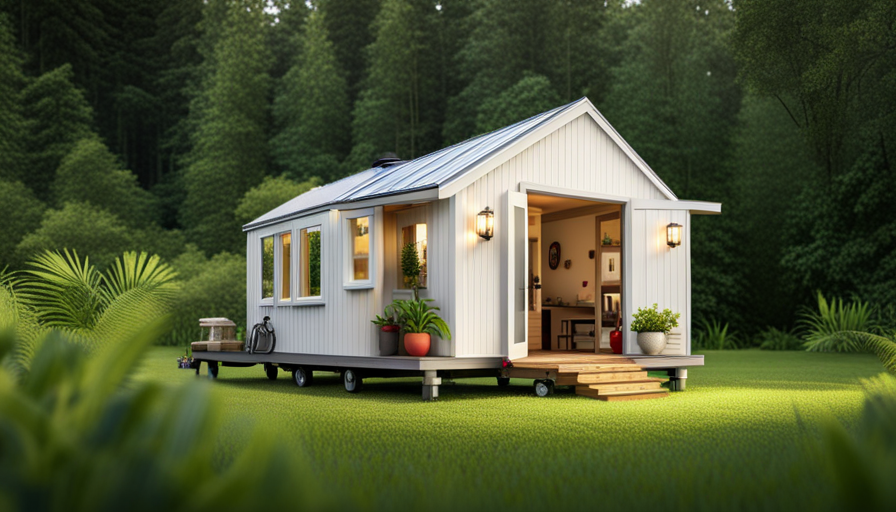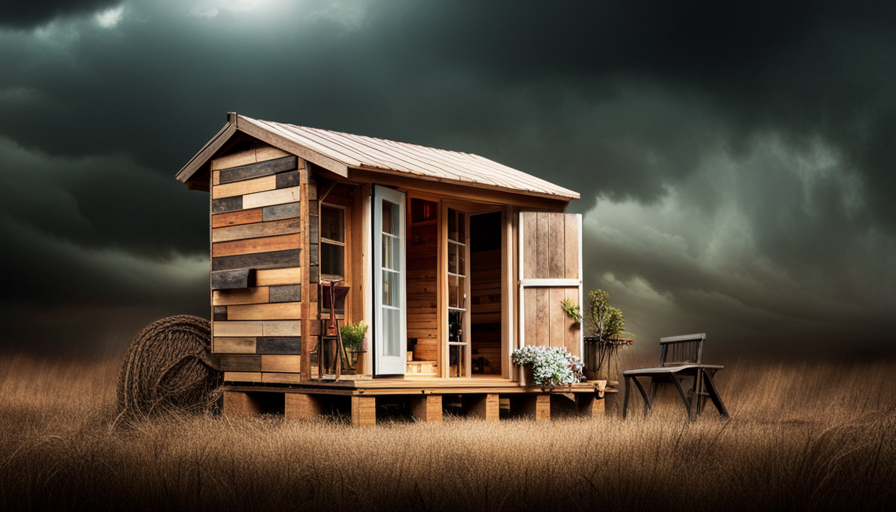Have you ever daydreamed about living in a small home? Imagine waking up each day in a cozy, functional space that perfectly fits your tastes and reflects your unique style. If you’re anything like me, you’ve probably spent countless hours watching ‘Tiny House Nation’ episodes, wondering, ‘How can I get on the show?’
The good news is, it’s not as impossible as it may seem. Just take the case of Sarah, a young architect from Seattle who had a passion for sustainable living and a knack for design. She applied to be on ‘Tiny House Nation’ and was selected to have her very own custom tiny house built on the show.
In this article, we’ll explore the steps Sarah took to get on the show and share some tips on how you can increase your chances of being chosen for this incredible opportunity. So, if you’re ready to turn your tiny house dreams into reality, keep reading!
Key Takeaways
- Conduct thorough research on the show’s requirements and understand the application process
- Determine a unique selling point for the tiny house concept and showcase it in the application video
- Consider partnering with a professional builder or designer to enhance chances of success and ensure a well-executed project
- Emphasize commitment to sustainable living and showcase dedication to creating innovative, functional, and eco-friendly living spaces.
Research the Show and Understand the Requirements
To get on Tiny House Nation, you’ve gotta do some research and understand the requirements. The first step is to familiarize yourself with the show. Watch previous episodes to get an idea of what they’re looking for and the tiny house building process. Pay attention to the design styles, layouts, and unique features that stand out.
Understanding the financial considerations is also important. Tiny house living can be more affordable than traditional housing, but it still requires careful planning and budgeting. Research the costs of materials, permits, and any additional expenses that may arise during the construction process.
Once you have a good grasp of the show’s requirements and the financial aspect, it’s time to determine your unique selling point. Think about what makes your tiny house concept stand out from the rest. Whether it’s an innovative design, a specific theme, or sustainable features, make sure to highlight what sets your tiny house apart.
Determine Your Unique Selling Point
Discovering your distinctive selling point is crucial in standing out from the crowd and leaving a lasting impression on the audience, like a shining star in a moonless night.
To identify your unique selling point, start by understanding your target audience. Consider who would be interested in your tiny house and what features would appeal to them. This will help you tailor your design and presentation to meet their needs and desires.
Additionally, conducting market analysis and competition research is essential. Take the time to research other tiny homes featured on the show and in the market. Identify what sets them apart and how you can differentiate yourself. Look for gaps in the market that you can fill with your unique ideas or innovative designs.
By understanding your target audience and conducting thorough market research, you can determine your unique selling point. This will help you stand out from the competition and increase your chances of being selected for Tiny House Nation. With a clear understanding of what makes you special, it’s time to create a compelling application video that showcases your unique selling point and leaves a lasting impression on the show’s producers.
Create a Compelling Application Video
Crafting an impressive application video is crucial to stand out and leave a lasting impression on the producers of Tiny House Nation. To create a compelling video, it’s important to utilize effective filming techniques and storytelling strategies.
When it comes to filming techniques, consider using a combination of wide shots to showcase the overall design of your tiny house, as well as close-ups to highlight unique features and intricate details. Additionally, incorporating time-lapse footage can add visual interest and demonstrate the progress of your project.
In terms of storytelling strategies, focus on presenting a clear and concise narrative that highlights your passion for tiny house living and your personal journey of creating your dream home. Share your motivations, challenges, and any innovative solutions you’ve implemented in your design. Consider adding testimonials from friends, family, or previous clients to showcase the impact your tiny house has had on their lives.
Remember to keep the video length within the specified time limit and maintain a high production quality.
By creating an application video that effectively utilizes filming techniques and storytelling strategies, you can captivate the producers of Tiny House Nation and increase your chances of being selected for the show.
In the next section, I will discuss how to showcase your design and construction skills without writing a ‘step’.
Showcase Your Design and Construction Skills
Highlighting your design and construction skills will make your application video visually impressive and leave a lasting impression on the producers, but how can you effectively showcase your expertise in a way that stands out from the competition?
Here are three design tips and construction techniques to help you create a compelling application video:
-
Demonstrate your creativity: Show off your unique design ideas by creating a virtual tour of your tiny house concept. Use computer-generated graphics or 3D modeling to bring your vision to life. This will allow the producers to visualize your design skills and innovative ideas.
-
Showcase your attention to detail: Include close-up shots of your construction techniques to highlight your craftsmanship. Whether it’s intricate woodworking, creative storage solutions, or efficient space utilization, make sure to emphasize the quality and precision of your work.
-
Highlight your problem-solving abilities: Share any challenges you encountered during previous construction projects and how you overcame them. This will demonstrate your ability to think critically and adapt to different situations, which are valuable skills in the tiny house industry.
By incorporating these design tips and construction techniques into your application video, you will impress the producers and stand out from the competition.
Transitioning into the next section, it’s equally important to highlight your personal story and motivation.
Highlight Your Personal Story and Motivation
Emphasize your unique journey and deep-rooted passion for creating innovative living spaces, captivating the producers with your personal story and unwavering motivation.
My personal journey into the world of tiny house construction has been one of overcoming obstacles and pursuing my dreams. From a young age, I’ve always been fascinated by architecture and design, constantly sketching and imagining unique living spaces. However, life threw me a curveball when I faced financial difficulties, making it seemingly impossible to pursue my passion. But I didn’t let that stop me.
I decided to educate myself and learn everything I could about tiny house construction. I enrolled in workshops, read books, and watched countless tutorials online. I saved every penny I could, working multiple jobs to fund my dream. Through sheer determination and perseverance, I finally built my own tiny house, turning my vision into reality.
My motivation stems from the belief that everyone deserves a comfortable and affordable home, regardless of their circumstances. I want to inspire others to embrace the tiny house movement and discover the freedom and simplicity it can bring to their lives. By showcasing my personal journey and the obstacles I’ve overcome, I hope to convey my unwavering commitment to creating innovative living spaces.
Consider partnering with a professional builder or designer who shares your vision and can help bring your ideas to life.
Consider Partnering with a Professional Builder or Designer
Consider teaming up with a skilled builder or designer who shares your vision and can help turn your innovative living space ideas into a reality. Remember, ‘two heads are better than one’ when it comes to creating a truly exceptional home.
Partnering with a professional builder or designer can greatly increase your chances of getting on Tiny House Nation and enhance the overall quality of your application video. They bring their design and construction skills to the table, helping you showcase your personal story, motivation, and commitment to sustainable living.
A professional builder or designer can provide valuable guidance and expertise throughout the application process, ensuring that your submission stands out from the rest. They can help you create a unique and functional tiny house design that addresses the challenges of tiny house living, such as maximizing space and storage solutions.
Partnering with a professional also demonstrates your commitment to the project, as it shows you are willing to invest in the expertise needed to create a successful tiny home.
By teaming up with a professional builder or designer, you are not only increasing your chances of getting on the show, but also ensuring that your tiny house project is well-executed. It’s important to stay patient throughout the application process and be prepared for the challenges of living in a tiny house.
Be Prepared for the Challenges of Living in a Tiny House
While teaming up with a professional builder or designer can greatly enhance your chances of success, it’s important to anticipate and embrace the unique challenges that come with living in a tiny house. Living in a small space requires a shift in mindset and lifestyle. It’s crucial to be prepared for the challenges that may arise, but also to recognize the benefits that come with this alternative way of living.
Living in a tiny house presents its fair share of challenges. One of the main obstacles is the limited space. With less square footage, it’s necessary to be intentional about what possessions are essential and to maximize storage solutions. Additionally, the lack of space can make everyday tasks, such as cooking and cleaning, more challenging. However, overcoming these challenges can lead to a simpler, more minimalist lifestyle, with less clutter and a greater focus on what truly matters.
On the flip side, there are numerous benefits to living in a tiny house. Financially, the reduced cost of living and lower maintenance expenses can provide greater financial freedom. Moreover, tiny houses are often more environmentally friendly, requiring fewer resources to build and maintain. The smaller footprint also encourages a more sustainable lifestyle, with opportunities for energy efficiency and reduced waste.
Transitioning into the subsequent section about ’emphasize your commitment to sustainable living’, it’s important to recognize that living in a tiny house inherently promotes sustainable practices.
Emphasize Your Commitment to Sustainable Living
Living in a tiny house may come with its fair share of challenges, but I’m determined to make it work. One aspect that I’m particularly committed to is sustainable living. I’m emphasizing my dedication to using sustainable materials and maximizing energy efficiency in the hope of catching the attention of the producers of Tiny House Nation.
When it comes to sustainable materials, I plan to make use of recycled or reclaimed resources whenever possible. Not only will this help reduce waste, but it’ll also add a unique character to my tiny home.
Additionally, I’ll prioritize energy efficiency by incorporating solar panels, energy-saving appliances, and smart home technology into my design. This will not only minimize my environmental impact but also save me money on utilities in the long run.
In order to evoke emotion and emphasize the importance of sustainable living, I want to highlight three key benefits:
- Decreasing my carbon footprint and helping to combat climate change.
- Supporting local artisans and businesses that specialize in eco-friendly materials.
- Creating a healthy and toxin-free living space for myself and the planet.
By showcasing my commitment to sustainable living, I hope to prove that I’m deserving of a spot on Tiny House Nation. So, let’s move on to the next step and explore how being open to the show’s guidance and expertise can help me achieve my dream of living in a tiny house.
Be Open to the Show’s Guidance and Expertise
Open yourself to the invaluable guidance and expertise offered by the show, and let their seasoned knowledge and insights guide you towards the fulfillment of your dream.
When preparing your application video for Tiny House Nation, it’s important to emphasize your commitment to sustainable living. Share your personal story and motivation behind wanting to live in a tiny house, highlighting the challenges you’ve faced and the research you’ve done to make this lifestyle choice.
The show’s guidance and expertise will play a crucial role in helping you navigate the requirements and intricacies of building a tiny house. They’ve got a wealth of experience in designing and constructing these unique homes, and their insights can help you overcome any obstacles you may encounter. Their knowledge of sustainable materials, energy-efficient systems, and space-saving techniques can greatly enhance your tiny house journey.
Incorporate your partner’s involvement and commitment to the project as well. Show how you both are aligned in your desire to live a simpler, more sustainable life. This’ll demonstrate your dedication and increase your chances of being selected for the show.
With the show’s guidance, you’ll learn how to maximize your limited space, create functional layouts, and incorporate innovative design elements.
So, submit your application and stay patient as you await the opportunity to embark on this incredible adventure.
Submit Your Application and Stay Patient
After being open to the guidance and expertise of ‘Tiny House Nation,’ the next step is to submit your application and stay patient.
The application process is crucial in your journey to getting on the show. Start by researching the requirements for applying. This will ensure that you meet all the necessary criteria and increase your chances of being selected. The show is looking for individuals who are truly committed to the tiny house lifestyle and have a compelling story to share.
Once you have gathered all the required information, it’s time to submit your application. Be thorough and honest when filling out the forms, as this will help the casting team get to know you better. Include any relevant details about your current living situation, your reasons for wanting a tiny house, and any challenges you may be facing.
While waiting for a response, take the opportunity to find inspiration for your tiny house project. Research different designs, layouts, and innovative storage solutions. Look for ideas that align with your personal style and needs. This will not only help you visualize your future tiny home but also demonstrate your commitment and dedication to the show’s concept.
Remember, the application process can take time, so stay patient and positive. Keep researching and finding inspiration to fuel your excitement for the possibility of being featured on ‘Tiny House Nation.’
Frequently Asked Questions
Can I apply to be on Tiny House Nation if I don’t have any design or construction skills?
I don’t need design or construction skills to apply for Tiny House Nation. While having these skills could be beneficial, it isn’t a requirement. The application process focuses more on showcasing my personality, creativity, and passion for tiny homes.
To make my application video stand out, I can highlight my unique ideas, explain why I want to be on the show, and demonstrate my commitment to the tiny house movement.
How can I make my application video stand out from the rest?
To make my application video stand out from the rest, I’ll focus on making a memorable impression and showcasing my unique personality. I’ll start by introducing myself confidently and passionately, highlighting my reasons for wanting to be on Tiny House Nation.
I’ll use creative visuals and storytelling techniques to engage the audience and leave a lasting impression. Additionally, I’ll ensure that my video reflects my individuality and genuine enthusiasm for tiny house living.
Is there a specific size requirement for the tiny house I want to build?
I’m not gonna lie, finding the specific size requirement for your tiny house can be a bit tricky.nnIt really depends on the regulations in the area where you plan to build.nnHowever, having some construction skills under your belt will definitely come in handy.nnIt’s important to do your research and consult local building codes to ensure your tiny house meets all necessary requirements.
Will the show cover the cost of building materials for the tiny house?
The show doesn’t cover the cost of building materials for the tiny house. Eligibility criteria for the show may vary, but typically involve having a compelling story or unique design concept. While the show provides expert guidance and assistance, the financial responsibility for building materials falls on the homeowners. It’s important to factor in the cost of materials when planning to be on Tiny House Nation.
How long does it usually take for the show to respond to a submitted application?
Typically, the show takes around 3-4 weeks to respond to a submitted application. For example, my friend applied to be on Tiny House Nation and received a response within 3 weeks.
The application process involves filling out a detailed form and submitting it along with photos and videos of your proposed tiny house project. The show’s producers carefully review each application to select participants who have unique and interesting stories to share.
Conclusion
After researching the show and understanding the requirements, I’m determined to get on Tiny House Nation. I’ll start by determining my unique selling point and creating a compelling application video. I’ll showcase my design and construction skills, while also highlighting my personal story and motivation. I’ll make sure to be prepared for the challenges of living in a tiny house and emphasize my commitment to sustainable living. I’ll be open to the show’s guidance and expertise, and once I’ve completed my application, I’ll eagerly wait for my chance to step into the spotlight of Tiny House Nation. Like a small but mighty seed planted in fertile soil, I hope to grow and flourish in this exciting opportunity.
Hi, I’m Emma. I’m the Editor in Chief of Tiny House 43, a blog all about tiny houses. While tree houses are often associated with childhood, they can be the perfect adult retreat. They offer a cozy space to relax and unwind, surrounded by nature. And since they’re typically built on stilts or raised platforms, they offer stunning views that traditional homes simply can’t match. If you’re looking for a unique and romantic getaway, a tree house tiny house might just be the perfect option.
